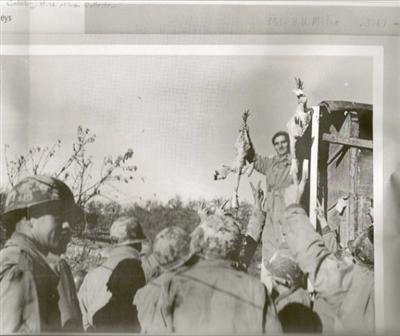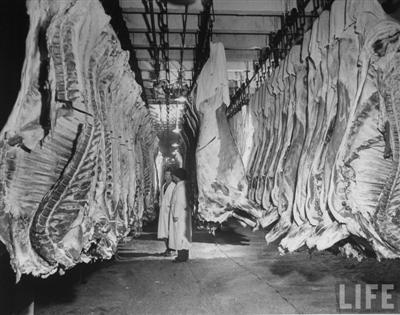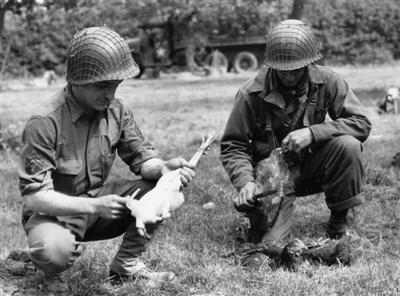Non Ration Foodstuffs: Normandy
Published: Winter, 2010
Author: Charles McFarlane
90th IDPG
Ok, so by now you're probably thinking this is getting a bit ridiculous - as you cant just go into a farmer's field and blast a cow, or plug any old animal you see walking around at an event because youre hungry. Then the question is logistics as a modern reenactor to keep things cool or cook them.We cant totally recreate what it was like then, as some of the unique opportunities just dont present themselves now as they did then - but it certainly would be an interesting exercise to attempt it.
Without further ado - meat.
Meat
Photo from the Normandie Archive“ The Krauts sometimes used herds of livestock for cover and drove them ahead of the infantry in an attack. Weather the attack was successful or not, both sides usually got fresh meat out of it… It’s astounding how many soldiers before cleaning their rifles squeezed off a couple of rounds to loosen the dirt in the barrels and a cow just happened to be standing there… to keep a respectful wide No Man’s Land between their [Germans] and our own [US]. The Boys [GI’s] took advantage of this and used to run down rabbits and chickens far ahead of our forward machine-gun positions.”
Page: 173 to 176, Up Front by Bill Mauldin Published by W. W. Norton & Company-
Your options on meat are pretty wide open. As much as the idea of "crafting a back story" can be dismissed or discounted as crockery - it really has to come into play when you just show up magically at an event with a primal cut of beef, parts of a pig, a whole bird or various processed meat products. Its not just as simple as killing an animal at the event or going into a shot up town and taking what you want.
Much of what was available today was available then - it just may be a bit harder to find in unprocessed or minimally processed forms. Beef, Pork, Chicken and game animals are all fair game.
Sometimes you can fit this whole concept together with an event specific impression, to actually retell some of the veteran's stories.
Photo from the Life Archive powered by Google
“We caught wind that there was an enormous slaughterhouse, open for business in our sector of the city…Dressed pork half’s and huge quarters of beef packed the cooling room…we helped ourselves to all we could carry. You couldn’t look in any direction without seeing a dirty GI with a half a pig or quarter of a cow slung over his shoulder.”
Page: 172, Bootprints; An Infantrymen’s walk though World War Two, by Hobert Winebrenner Michael McCoy. Camp Camamajo Press-
Domestic Livestock - Cows, Pigs, Chickens
Basically, the thing to look for are large primal cuts, as minimally processed and butchered - or poorly butchered as possible.
In the instance of chickens, preferably a whole chicken, with feathers on would be ideal.
Photo from the Normandie Archive
This is really one of those "yeah right, who's really going to do it" kind of things - but it would be quite the spectacle if it was done, being memorable for both participant and spectator alike.
Preserved Meat
Ok, so this is by far the easier and more reasonable option.
You have 2 paths on this delicious journey - canned and dry packed.
Smoked meats / Dry Packed
There are a variety of dry packed, smoked and cured meat products available commercially now that were available during the war. Cured or smoked beef, pork, duck or mixed meat products would all be correct. Just make a point to avoid modern highly processed commercial products such as Hickory Farms, slimjims, jack-links, oberto, pepperoni logs, or "jerky" products.
During the war, families sent Salami to their boys serving overseas, “Send a Salami to your boy in the Army” was a slogan that Katz Deli coined during the war (http://www.katzdeli.com/).
Dried meats are a good alternative to fresh meat that could be hard to store at an event.
I would like to go with dried meats, should I just got get some beef jerky?
NO. Go to a deli butcher shop or specialty dried meat store and get nice European salami, not the bags of jerky or 2 foot long pepperoni stones.
Also check your local butcher shop for other dried meats.
Here is a place where you can find French dried meats:
http://www.thefrenchybee.com/meat-charcuterie-smoked-dry-cured-meats-c-145_150.html
Game
Some of the most vivid stories recounted to me by veterans have been of taking game while in europe with various weapons, both fissure and capture - as well as various other "methods".
“A number of backyards maintained pen, which housed tender young rabbits. We gathered a bushel basket full, maybe a dozen to feed our small group.”
Page: 171, Bootprints; An Infantrymen’s walk though World War Two, by Hobert Winebrenner Michael McCoy. Camp Camamajo Press-
Small game such as rabbits, duck, pigeons and red squirrel were fairly commonplace and accessible to GI's.
Photo from the Normandie Archive
Venison was also eaten by the GI’s but on a limited basis, I would say it would be more common later during the war when GI’s had time to hunt deer and not the enemy.
Of particular note were photos from the late winter / spring of 1945 in the 90th Division Association collection of deer that had been taken with M1 Carbines and captured MP44's. Admittedly this is unrelated to food of Normandy, but I always chuckle at the thought of the photos.You may be able to find duck and rabbit / hare at some local butchers depending on where in the country you live. Other game may be significantly more difficult - requiring you to take it yourself before the event.
Conclusions:
While I've gone into specific details on some things, yet left much wide open on others - my whole message and underlying hope of this article is to get you to think about the food you take to an event just as much as you would what uniforms or equipment you would take.
If you want to go above and beyond the basic issue rations - there are numerous options available for non ration foodstuffs which are period and region specifically correct.
Just grabbing any old loaf of "French" bread, some "cheese" and "wine" does not make it correct for what we do. To me,doing that is the same as grabbing a loaf of WonderBread, a bottle of Boonesfarm and a pack of processed American cheese singles and putting on some French Ranger boots and calling it quits. For really not that much more time, money or effort you can get a more correct Miche or Boule, a block of Camembert, and a jug of cider to pour into a period bottle.
While there may be endless technicalities and intricacies when it comes to civilian food, packaging and presentation - I hope this article has given you some direction and motivation towards continuing your research and potential use of period and region correct civilian foods in your impression.
Do it for yourself, do it for your friends, non ration correct period foodstuffs can make a huge impact on your event experience. Try it out, you may have a great time doing it and really enjoy it. You may even gather a crowd when you do it...

Photo from the Normandie Archive
90th
IDPG Research








